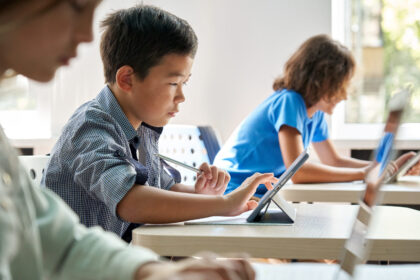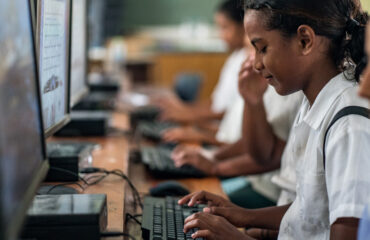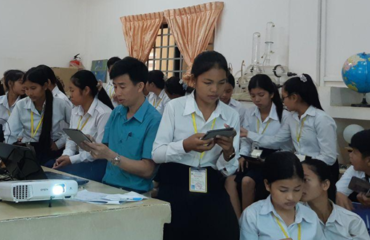
As teachers, we all know that we are likely to find a range of abilities in any class group. In June this year (2022) the World Bank revealed that the level of ‘learning poverty’ in low- and middle-income countries (LMIC) has been exacerbated by the COVID-19 pandemic. An estimated 7 in 10 of all children in LMICs cannot read a simple text with comprehension by age 10. [1] These children are fated to fall further and further behind as they progress to higher grade levels where the ability to read becomes increasingly important. The issue of learning poverty is often compounded by textbooks exceeding the reading level of most students of the class. Indian education economist Karthik Muralidharan notes that in many struggling education systems, “textbooks are usually written by elites and only benefit the best students” (Mirchandani 2015). [2] Faced with such challenges, teachers often resort to teaching to the middle of the class, or even to the top of the class, guaranteeing that some of their students will be left behind.
How can education technology (EdTech) enable teachers to address such constraints to learning?
It is increasingly thought that the answer lies in differentiated learning. The UNESCO International Bureau of Education defines differentiated learning as ‘An approach to teaching that involves offering several different learning experiences and proactively addressing students’ varied needs to maximize learning opportunities for each student in the classroom.’[3]
In high-tech environments where students have access to individual devices, this can involve using tools such as Nearpod or Blendspace to curate lesson workflows for different students or student groups. Nearpod provides real-time insights into student understanding through interactive lessons andvideos, gamification, and activities. This allows teachers to create customized activities for self-paced individual work or group work at the ‘right level’. Blendspace allows teachers to draw together digital materials from a range of sources to create individualized learning spaces. To ensure that material is presented at an appropriate level, teachers can make use of resources such as Newsela which provides Science & Math, Social Studies, and Socio-Emotional Learning content at 5 reading levels. In specific subject areas, there is an increasing range of tools that use artificial intelligence (AI) to automatically select content based on student performance so that the student is always presented content at a level which is slightly challenging for them without being overwhelming. Examples include i-Ready personalised learning in Reading and Mathematics for grades K-8 and the Khan Academy tools for learning Science and Math concepts.
The key to differentiated learning is using formative assessment to adjust the learning experience for the student. While AI enables an increasing range of personalised learning software to do this automatically, teachers can also draw on digital formative assessment tools to give them quick assessments of student’s understanding enabling them – to manually adjust their teaching. Options include Socrative, Poll Anywhere, Mentimeter, or Kahoot. All of these tools provide quick assessments of student understanding in a fun, anonymous and hence stress-less manner. EdPuzzle allows teachers to integrate quizzes into videos. ASSISTments allows Math teachers to assign problem sets; students doing the exercise get automatic feedback while the teacher receives reports on their performance.
There is increasing evidence for the value of formative assessment, or “assessment for learning” (Wiliam 2013). This assessment is not primarily about collecting data on students’ performance but as , Benjamin Bloom observed half a century ago, “We see much more effective use of formative evaluation if it is separated from the grading process and used primarily as an aid to teaching” (Bloom 1969, p. 48). Formative assessment takes place during learning, not after. [4]
Why then do we so often see teachers neglecting formative assessment options, ignoring the needs of individual learners in their class, and using EdTech to support teacher-centered pedagogies? Content-heavy PowerPoint presentations or even textbook exercises are projected onto a screen or SmartTV forcing all students to move through the lesson at the same pace (or to switch off). Digitized games which could be highly motivational if used on individual devices are likewise projected to the whole class discouraging all but a small percentage from participating. Is this helping the teacher? Most definitely. It reduces preparation time, particularly if the digital materials are provided by a textbook publisher as is common in some countries, and if materials can be reused the following year. Focusing student attention to the front of the room also helps maintain teacher control of the class. Is it helping the students? Generally, not. These scenarios only represent the digitization of traditional teacher-centered pedagogies and cater to a small portion of the class while less able students fall further and further behind.
The Technology-Enabled Innovation in South-East Asia (TIESEA) project recognises the importance of learner-centered pedagogies and strives to use EdTech to promote and support such approaches. In Viet Nam, the project will pilot the use of the Elsa Speak app which uses AI to help students of English improve their pronunciation skills. Students will be provided with smartphones which they can use to practice at home. This recognises research that found higher achievement levels in interventions that effectively extended the school day. [5] Teachers will receive training in how to facilitate communicative English as mandated by the government of Viet Nam in their latest curriculum revision. In Cambodia and Indonesia, STEM students who live in small communities close to their school will be able to work on real world projects together using Internet resources accessed through a mesh network (Cambodia) or from an offline content server (Indonesia and Cambodia). Once again, teachers will be supported with training in learner-centered teaching approaches. In Indonesia, this will be done with the assistance of Guru Penggerak – teachers in model schools trained to implement the Ministry of Education and Culture’s progressive Kurikulum Merdeka and, in Cambodia, by the Kampuchea Action to Promote Education (KAPE) NGO.
The implementation plan for the TIESEA pilot can be found here.


